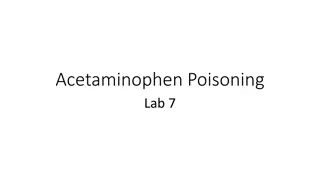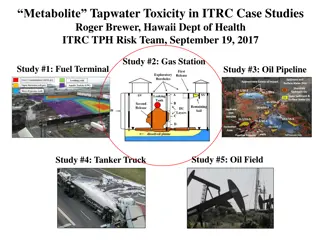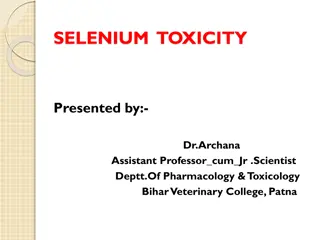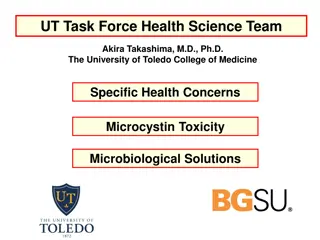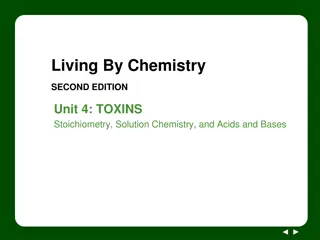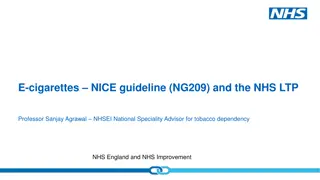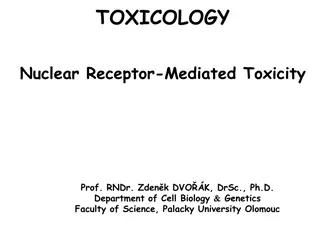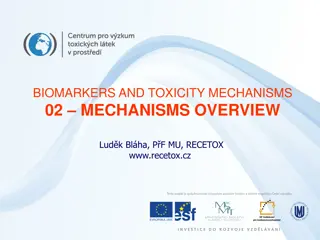Understanding Nicotine Toxicity: A Comprehensive Overview
Nicotine, a toxic substance found in tobacco plants, has therapeutic uses in treating nicotine dependence. However, exposure to nicotine can lead to toxicity, with symptoms such as Green Tobacco Sickness (GTS). Understanding the absorption, distribution, and metabolism of nicotine is crucial in managing its effects on the body. This detailed account unravels the complexities of nicotine toxicity, shedding light on its various aspects from absorption routes to metabolic pathways.
Download Presentation

Please find below an Image/Link to download the presentation.
The content on the website is provided AS IS for your information and personal use only. It may not be sold, licensed, or shared on other websites without obtaining consent from the author. Download presentation by click this link. If you encounter any issues during the download, it is possible that the publisher has removed the file from their server.
E N D
Presentation Transcript
Nicotine Toxicity 4thstage Assistant lecturer: Shahad S.aldeen Department of pharmacology and toxicology June-2021
Introduction Nicotine is a toxic substance found in the tobacco plant (Nicotiana tabacum). The commercial preparation of the plant involves drying the leaves for the production of chewing tobacco, cigars, cigarettes, & snuff. Nicotine is easily isolated from the plant for use in nicotine replacement products (gum, patches, & nasal spray)
Therapeutic uses of nicotine Primary TU of nicotine is in treating nicotine dependence in order to eliminate smoking. Example : NICORETTE GUM used to treat nicotine addiction .
Green Tobacco Sickness (GTS) A set of symptoms caused by nicotine poisoning, often due to exposure during tobacco harvesting. Management If the skin exposed to wet tobacco leaves, conc. nicotine liquid, or nicotine pesticide , patient's clothing promptly removed & the skin thoroughly washed with soap & water.
Absorption of nicotine Nicotine has pKa value of 7.9, its well absorbed through the buccal mucosa, respiratory tract, intestinal tract, and skin. Absorption of nicotine across biological membranes depends on pH (hyperacidity reduce absorption since it become in ionized form which is less absorbable).
Distribution of nicotine Nicotine generally achieves a volume of distribution of 1 L/kg. reaches the brain in approximately 8 seconds, with CNS levels of nicotine rising rapidly & then declining rapidly as the drug is redistributed to other tissues. Nicotine readily cross the placenta & also transmitted in small concentrations in breast milk.
Metabolism of nicotine Metabolism takes place primarily in CYP450 system of the liver (80- 90%), but also, to lesser extent, in the kidney & lung. Nicotine t1/2 is 1-4 hr & the main oxidative metabolites of nicotine are: 1- Cotinine (major) 2- Nicotine 1-N-oxide (minor)
Execration of nicotine Primarily in urine In Breast milk (in heavy smoker about 0.5 mg/L of milk), & this is large dose since infant is small.
Mechanism of toxicity In adrenal medulla: By binding to nicotinic receptors in the adrenal medulla nicotine increases flow of (epinephrine), a stimulating hormone & neurotransmitter. At nicotine binds to the receptors, it causes cell depolarization & influx of Ca through voltage-gated Ca+ channels. Calcium triggers the exocytosis of chromaffin granules & thus the release of epinephrine (& NE) into bloodstream. The release of epinephrine (adrenaline) causes an increase in heart rate, blood pressure & respiration, as well as higher blood glucose levels.
In CNS: By binding to nicotinic Ach receptors, nicotine increases the levels of several NT, It is thought that increased levels of dopamine in the brain which responsible for the euphoria & relaxation and eventual addiction caused by nicotine consumption. Nicotine has higher affinity for Ach receptors in brain than those in skeletal muscle, though at toxic doses it can induce contractions & respiratory paralysis.
Acute nicotine toxicity Acute nicotine exposure occurs from insecticide sprays or tobacco ,it associated with nausea, vomiting, salivation, diarrhea, dizziness, mental confusion, weakness Acute nicotine toxicity characterized by The biphasic pattern, started as initial stimulation ( H.R., B.P., R.R, hyperactivity) followed quickly by inhibition ( H.R., B.P., R.R, hypoactivity) & if the death occur, attributed to respiratory paralysis.
Cont. Fatal exposure (60 mg fatal for adult) Decreased blood pressure Difficult breathing Irregular pulse Convulsions Respiratory failure & death.
Management 1. Orogastric lavage if pt with oral exposure 2. Activated charcoal effectively binds nicotine & should be used to absorption. 3. Symptomatic treatment : Seizures benzodiazepines. Cardiovascular compromise atropine for symptomatic bradycardia fluids for hypotension. dopamine or nor epinephrine If hypotension does not respond to fluids. Respiratory compromise oxygen
Note: there is no specific antidote, only for animals we can use mecamylamine, hexamethonium & pimpedine.
Not recommended management Induction of emesis not recommended because nicotine poisoning may cause unexpected seizures or respiratory depression. Urine acidification for enhancing elimination un necessary since it may cause complications of metabolic acidosis.
Procedure for nicotine toxicity 5 cigarettes macerated in 50 ml hot D.W. overnight then filtered by filter paper. 5 mice given 15, 18, 20, 22, 25 units IP. respectively of nicotine solution. Observe the biphasic pattern of nicotine toxicity that started as stimulation followed by depression then death if it occur. LD50% of nicotine for mice is 3 mg/kg



